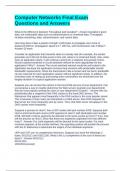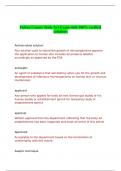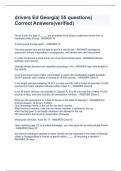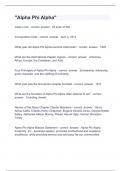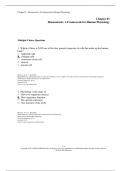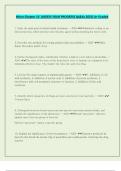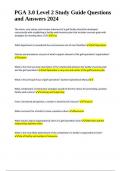Computer Networks Final Exam
Questions and Answers
What is the difference between Throughput and Goodput? - Answer-Goodput is good
data, not undesirable data such as retransmissions or overhead data. Throughput
includes everything, data, retransmission, and control data.
How long does it take a packet of length 1,000 bytes to propagate over a link of
distance2,500 km, propagation speed 2.5 * 108 m/s, and transmission rate 2 Mbps? -
Answer-10 msec
Consider an application that transmits data at a steady rate (for example, the sender
generates an N-bit unit of data every k time unit, where k is small and fixed). Also, when
such an application starts, it will continue running for a relatively long period of time.
Would a packet-switched or circuit-switched network be more appropriate for this
application? Why? - Answer-The circuit-switched network would be well suited to the
application because the application involves long sessions with predictable smooth
bandwidth requirements. Since the transmission rate is known and not burst, bandwidth
can be reserved for each application session without significant waste. In addition, the
overhead costs of setting up and tearing down connections are amortized over the
lengthy duration of a typical application session.
Suppose you can access the caches in the local DNS servers of your department. Can
you propose a way to roughly determine the Web servers (outside your department)
that are most popular among the users in your department? Explain. - Answer-We can
periodically take a snapshot of the DNS caches in the local DNS servers. The
Webserver that appears most frequently in the DNS caches is the most popular server.
This is because if more users are interested in a Web server, then DNS requests for
that server are more frequently sent by users. Thus, that Web server will appear in the
DNS caches more frequently.
Suppose a process in Host C has a UDP socket with port number 6789. Suppose both
Host A and Host B each send a UDP segment to Host C with destination port number
6789. Will both of these segments be directed to the same socket at Host C? If so, how
will the process at Host C know that these two segments originated from two different
hosts? - Answer-Yes, both segments will be directed to the same socket. For each
received segment, at the socket interface, the operating system will provide the process
with the IP addresses to determine the origins of the individual segments.
UDP and TCP use 1s complement checksum. Suppose you have the followings 2
bytes: 00110111 and 01011100. What is the 1s complement of the sum of those two
bytes? - Answer-00110111
01011100+
10010011(answer)
, 01101100(1s complement)
Why does UDP take the 1s complement of the sum? How does the receiver detect
errors? is it possible that 1 bit errors go undetected? What about 2 bit? - Answer-To
detect errors, the receiver adds the three words (the two original words and the
checksum). If the sum contains a zero, the receiver knows there has been an error. All
one-bit errors will be detected, but two-bit errors can be undetected (e.g., if the last digit
of the first word is converted to a 0 and the last digit of the second word is converted to
a 1).
In our rdt protocol, why did we introduce sequence numbers?
in our rdt protocol, why did we introduce timers - Answer-Sequence numbers are
required for a receiver to find out whether an arriving packet contains new data or is a
retransmission. To handle losses in the channel. If the ACK for a transmitted packet is
not received within the duration of the timer for the packet, the packet (or its ACK or
NACK) is assumed to have been lost. Hence, the packet is retransmitted.
suppose Host A sends two TCP segments back to back to host B over a TCP
connection. The first segment have a sequence number of 90. The second has a
sequence number of 110.
How much data is in the first segment?
Suppose that the first segment is lost but the second segment arrives at B. In the
acknowledgement that Host B sends to Host A, what will be the acknowledgement
number? - Answer-a) 20 bytes b) ack number = 90
Given an IP address and mask of 180.3.70.5/16, design an IP addressing scheme that
satisfies the following requirements: Serve 50 subnets For first and second subnets,
what is the network address, broadcast address, first usable address, and last usable
address? - Answer-First subnet
180.3.68.0 --- NA
180.3.68.1 ---- First usable
180.3.71.254 ---- Last usable
180.3.71.255 --- BA
Second subnet
180.3.72.0 --- NA
180.3.72.1 ---- First usable
180.3.75.254 ---- Last usable
180.3.75.255 --- BA
Suppose Host A sends Host B a TCP segment encapsulated in an IP datagram. When
HostB receives the datagram, how does the network layer know it should pass the
segment(that is, the payload of the datagram) to TCP rather than to UDP or to
something else? - Answer-The 8-bit protocol field (upper layer) in the IP datagram
contains information about which transport layer protocol the destination host should
pass the segment to.
Questions and Answers
What is the difference between Throughput and Goodput? - Answer-Goodput is good
data, not undesirable data such as retransmissions or overhead data. Throughput
includes everything, data, retransmission, and control data.
How long does it take a packet of length 1,000 bytes to propagate over a link of
distance2,500 km, propagation speed 2.5 * 108 m/s, and transmission rate 2 Mbps? -
Answer-10 msec
Consider an application that transmits data at a steady rate (for example, the sender
generates an N-bit unit of data every k time unit, where k is small and fixed). Also, when
such an application starts, it will continue running for a relatively long period of time.
Would a packet-switched or circuit-switched network be more appropriate for this
application? Why? - Answer-The circuit-switched network would be well suited to the
application because the application involves long sessions with predictable smooth
bandwidth requirements. Since the transmission rate is known and not burst, bandwidth
can be reserved for each application session without significant waste. In addition, the
overhead costs of setting up and tearing down connections are amortized over the
lengthy duration of a typical application session.
Suppose you can access the caches in the local DNS servers of your department. Can
you propose a way to roughly determine the Web servers (outside your department)
that are most popular among the users in your department? Explain. - Answer-We can
periodically take a snapshot of the DNS caches in the local DNS servers. The
Webserver that appears most frequently in the DNS caches is the most popular server.
This is because if more users are interested in a Web server, then DNS requests for
that server are more frequently sent by users. Thus, that Web server will appear in the
DNS caches more frequently.
Suppose a process in Host C has a UDP socket with port number 6789. Suppose both
Host A and Host B each send a UDP segment to Host C with destination port number
6789. Will both of these segments be directed to the same socket at Host C? If so, how
will the process at Host C know that these two segments originated from two different
hosts? - Answer-Yes, both segments will be directed to the same socket. For each
received segment, at the socket interface, the operating system will provide the process
with the IP addresses to determine the origins of the individual segments.
UDP and TCP use 1s complement checksum. Suppose you have the followings 2
bytes: 00110111 and 01011100. What is the 1s complement of the sum of those two
bytes? - Answer-00110111
01011100+
10010011(answer)
, 01101100(1s complement)
Why does UDP take the 1s complement of the sum? How does the receiver detect
errors? is it possible that 1 bit errors go undetected? What about 2 bit? - Answer-To
detect errors, the receiver adds the three words (the two original words and the
checksum). If the sum contains a zero, the receiver knows there has been an error. All
one-bit errors will be detected, but two-bit errors can be undetected (e.g., if the last digit
of the first word is converted to a 0 and the last digit of the second word is converted to
a 1).
In our rdt protocol, why did we introduce sequence numbers?
in our rdt protocol, why did we introduce timers - Answer-Sequence numbers are
required for a receiver to find out whether an arriving packet contains new data or is a
retransmission. To handle losses in the channel. If the ACK for a transmitted packet is
not received within the duration of the timer for the packet, the packet (or its ACK or
NACK) is assumed to have been lost. Hence, the packet is retransmitted.
suppose Host A sends two TCP segments back to back to host B over a TCP
connection. The first segment have a sequence number of 90. The second has a
sequence number of 110.
How much data is in the first segment?
Suppose that the first segment is lost but the second segment arrives at B. In the
acknowledgement that Host B sends to Host A, what will be the acknowledgement
number? - Answer-a) 20 bytes b) ack number = 90
Given an IP address and mask of 180.3.70.5/16, design an IP addressing scheme that
satisfies the following requirements: Serve 50 subnets For first and second subnets,
what is the network address, broadcast address, first usable address, and last usable
address? - Answer-First subnet
180.3.68.0 --- NA
180.3.68.1 ---- First usable
180.3.71.254 ---- Last usable
180.3.71.255 --- BA
Second subnet
180.3.72.0 --- NA
180.3.72.1 ---- First usable
180.3.75.254 ---- Last usable
180.3.75.255 --- BA
Suppose Host A sends Host B a TCP segment encapsulated in an IP datagram. When
HostB receives the datagram, how does the network layer know it should pass the
segment(that is, the payload of the datagram) to TCP rather than to UDP or to
something else? - Answer-The 8-bit protocol field (upper layer) in the IP datagram
contains information about which transport layer protocol the destination host should
pass the segment to.

